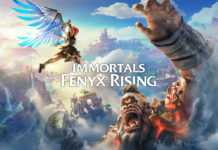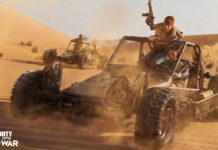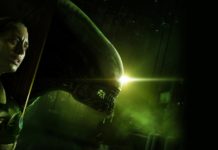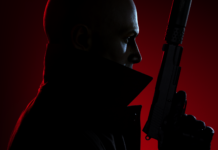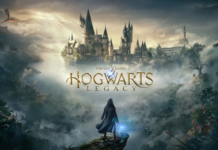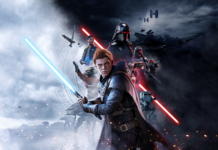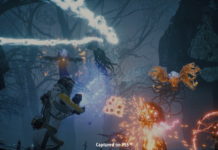The following shaky-cam footage came from 4gamer.net. For those who can’t understand Japanese, XA has combined the pieces into one media file.
6 minutes of shaky-cam gameplay footage
Also, check out this shaky-cam footage of the CG E3 trailer and see if you can ascertain any clues as to the plot from it. If you do, post them in the comments and heckle us for not being perceptive enough to catch them!
NOTE: For those who don’t feel as though they need to read impressions of the new visual style – a subjective matter which some might consider plainly obvious to anyone who looks at the screenshots or movies – feel free to skip to the story and combat sections of the review, marked by bold headings. The combat section is where most of the gameplay impressions are located, and is really where the quality and improvements made to the game become evident.
Every moment of one’s existence, one is growing into more, or retreating into less
Prior to 2003, Prince of Persia was a dead brand. While the first titles in the franchise were remembered as classics, revered for the innovations they brought to game design, the general feeling was that a Prince of Persia game would not sell as a result of changes that had taken place in the gaming market, and that was assuming that a new iteration in the franchise could be done well – a feat that the horrid nature of the most recent entries in the franchise (Prince of Persia 3D, for example) cast into doubt. Fresh off the success of the first Splinter Cell, Ubisoft Montreal took up the challenge of creating an experience that at once captured the magic of past titles, while at the same time introducing enough new elements to make it fresh and exciting. Suffice to say, they did just that; Prince of Persia: Sands of Time was the best game of 2003 and served to rejuvenate the franchise in the eyes of critics and hardcore gamers. Unfortunately, the game was not strong enough to endure the stigma associated with the franchise for many casual gamers in North America; despite universal acclaim for the title, the game just didn’t sell on western shores. Thankfully, strong sales in Europe bailed the gaming community out of an utter tragedy as a sequel to one of the best games in the current generation is receiving the sequel it deserves, and judging from the content presented thus far – illustrating the numerous changes that have been made to the weakest aspects of the original, Prince of Persia 2 is going to kick ass.
New Look
As good as Ubisoft’s entry in the Prince of Persia franchise was, it still had some problems that, while relatively small considering the amazing overall quality of the game, detracted somewhat from the experience and left room for improvement to be made by the sequel. One of the grievances that many people had with the game, albeit a fairly subjective one, was the nature of the main character: essentially the equivalent of a present-day cocky, self-centered, rich kid. While that technically fit with the character’s background – a prince, after all – and there was some maturation as the character progressed through the hardship of his journey (well right up to the ending, where he may have acted somewhat irresponsibly in one scene), the fresh-faced look and seemingly oblivious nature to the scope of the transpiring events made for a character that some gamers had trouble getting behind. Upon first glance, the first thing that strikes the observer – along with the overall change in aesthetic that the game has gone through – is the changes made to the main character. Through altering the nature of the prince (both in looks and personality) for the sequel, Ubisoft has at once made a character that is more marketable in today’s gaming climate, and is simply a better character overall. This newfound quality is a result of the multiple layers inherent to the character – many of which can be seen through his appearance alone.
The darker aura that surrounds the character gives a strong impression that he is entirely capable of killing you through any one of many sadistic methods and has endured, and been responsible for, numerous violent acts. This can be seen through the way he carries himself – cloaked and hooded, casting his face in shadow, ready to make first contact with the world around him not with his hands, but blood-drenched swords. At the same time, he has an air of expertise and maturity; experience has made him efficient, and he won’t do anything that isn’t absolutely necessary. He is not outwardly aggressive; there are no cocky poses or instigating attitude – he is perfectly content to allow you to live so long as you do not do something stupid. His weathered garments, tough skin, and aged steel speak volumes for the harsh travels he has been through. Finally, beneath the darkness exists a light just barely strong enough to make itself known through the vastness of his eyes and gives a sense that prince is a man that is kind to the innocent, loyal to his friends, and searching for a means to battle out from the darkness he resides in. The character is human, a person connected and reacting convincingly to the world that shaped him into the man he is – a more complex, relatable character should entice more gamers to get behind the controller in efforts to help him atone for past actions.
New Story
In the first game, the general motivation for the prince making his way through the palace (as opposed to heading straight for the door and getting the hell out of dodge) was essentially the rectification of a mistake he had made – namely, unleashing the sands of time. Redemption is once again used the driving force behind the main character’s journey in Prince of Persia 2, only this time the matter is far more personal – the prince is on a mission to save his own life from a predestined death – one bestowed upon him by fate as a result of some previous action relating to the sands of time (perhaps further punishment for some actions during the first game, or from the game’s ending?). Fate is more than a mere abstract concept in Prince of Persia 2, its a sentient entity which manifests itself into the physical form of an unstoppable (as in, unkillable) demon named Dahaka in order to stalk the prince, in addition to the countless inhuman minions that it has at its command. However, it seems as though the control fate exerts over events in the prince’s world is tied to the sands of time – and their destruction may be the key to the prince escaping his own fatal destiny. Over the course of this new journey, the prince will regain his ability to manipulate time. As of this point, it has yet to be disclosed how the prince manages to do so without the use of the dagger [that gave him the power to do so in the first game] but it has been revealed that the extents of his powers have been increased substantially. In the first game, the prince was able to backtrack in time approximately 10 seconds; he now has the ability to go back centuries at a time. This is implemented into the gameplay much in the same way the spectral plain was utilized in the Soul Reaver games – if an obstacle is obstructing the Prince’s progress, it may be possible to travel back in time to a point where the obstacle does not yet exist, and the prince can continue.
It should also be noted that the vast majority of the game does not take place in the prince’s world/reality. The prince’s journey requires that he find a specific location, one which houses the gateway between his realm and the one he needs to cross over to in order to fulfill the acts which may be the only way to save himself. The other realm appears to be one which mirrors our own (or the prince’s) as it is filled with human structures, and everything operates via the same physics (gravity, for example). It seems, however, that fate has power over this realm, and can twist and shape it at will. In this way, it is not only the enemies, but the environments themselves which be a constant hindrance to the prince’s progress. However, the prince still has the ability to shift time in this realm, and it is only after he crosses over that it is enhanced to the point where he can travel centuries at a time. Are the prince’s powers and fate’s power connected somehow?
New Combat
By far the biggest, and most frequent complaint leveled toward Prince of Persia: Sands of Time was that the combat system, while certainly acceptable, was nowhere near the level of quality inherent to every other facet of the gameplay. Simply put, the combat became an uninvolved experience for the player. Combat scenarios, rather than presenting an engaging challenge – presenting the player with opponents that demanded they have precise timing and judgment of when to attack, and what attacks to use, were an exercise in tedium. The player’s contribution was relegated primarily to the recognition of the enemy classes and employing the attacks that were most effective, interspersed with bouts of blocking. Challenge was never inherent to the actual combat, but merely to the number of opponents the game threw at the player – increasing the chance of the player taking enough damage [and using up all of their sand reserves] by prolonging the battles. After mere minutes with the game, it becomes obvious that Ubisoft Montreal has gone to great lengths in order to ensure that the combat is on par with the rest of the gameplay, if not better.
The prince is now a more skilled fighter; his arsenal of basic maneuvers has been expanded and now includes a variety of kicks in addition to more dynamic looking swordplay. The prince retains his impressive ability to run up the body of an opponent and attack while pivoting in mid air, but attack has been further developed and allows for a greater amount of choice on the part of the player. For example, in addition to flipping over the enemy and performing an attack in mid air, the prince now has the ability to vault himself from the enemy’s mid section (the command to do so is entered after the initial input, mid way through the animation) as a means of distancing himself from the enemy and any other baddies in the general vicinity (the height and distance produced by this maneuver is ridiculous, in a good way). Should the player choose to carry through the acrobatic attack, upon landing behind the enemy the prince can immediately use an assortment of new abilities to dispatch the vulnerable foe. For example, the second the prince hits the ground he can impale the enemy with his sword, take the enemy’s sword and decapitate him with it – all in one seamless motion. These fatal maneuvers are dependent on what secondary weapon the prince happens to be wielding, as each weapon class (dagger, sword, mace, etc) comes with its own barbaric finishing moves.
These maneuvers are exciting to watch and enjoyable to pull off, but the most useful of the prince’s new moves is a tactic ripped straight out of Ubisoft Montreal’s own Splinter Cell franchise; the ability to grab the adversary from behind and use it as a human shield. Both the appearance and execution of the maneuver mirror the modern stealth classic; once the prince has an enemy in this position, the enemy is completely debilitated (no worries of having to keep him from escaping your grasp), and can be used to absorb the attacks of his demonic cohorts, so long as they don’t attack the prince from behind. As of this point it is uncertain as to whether an enemy acting as a human shield can die (in the case of the standard enemies seen thus far, death means to disintegrate into dust) from absorbing too many of their comrades’ attacks. If this were the case, it would essentially give the prince another way of killing enemies – albeit a defensive/passive means, but would limit the amount of time that an enemy could be utilized to block attacks (whereas in Splinter Cell, a corpse still makes a mighty fine shield). If the enemy preserves its form regardless of how many attacks it has sustained, the prince is more than capable of disposing of his shield in one of two ways. The player can either throw the enemy towards another enemy, temporarily or by slicing the still-living enemy in half through the waist, resulting in a very cool animation where the two halves fall independently of each other in a morbidly realistic fashion. Once again, the method by which the prince discards the human shield varies with each weapon class, and all of them capture the new, darker atmosphere of the game (and the main character) perfectly.
While these new combat abilities would be enough to enhance the combat alone, they are only minor upgrades in comparison to the new free-form structure of the battles, a huge all-encompassing alteration that serves to mesh the decidedly separate gameplay systems of the first game into one. In Sands of Time, when the prince had his sword sheathed he was able to wall-run, run vertically up walls and jump off, climb pillars, swing on poles, and an assortment of other abilities that made him seem as though he had been bitten by a radioactive orangutan earlier in his life. This was in stark contrast to what the prince could do in the heat of battle, as his acrobatic abilities were essentially limited entirely to attacks, more for presentation’s sake than for actual practicality, as they provided little offensive benefit over a standard strike. With the new free-form nature of the fighting system, the prince is quite capable of implementing his platforming talent in the midst of combat. The prince can now wall-run in the middle of a fight without putting his sword away, and why would he when he’s perfectly capable of taking a swing at an enemy whilst wall-running past them? The player will also be able to use pillars to their advantage as well, as they are able to jump from the midst of conflict and cling to the pillar before vaulting off and attacking another enemy. An entirely new method of using columns was demonstrated at E3 wherein the prince was in a room that contained a group of enemies and a pole in the middle. With his sword drawn, the prince runs toward the poll, grabs hold with his free hand, swings around perpendicular to the floor and decapitates all the enemies in one fluid motion. ‘Cool’ doesn’t even begin to describe it. Such abilities are not relegated to individual use, either; an example of how such abilities could be used in sequence could see the player using the previously mentioned vault maneuver to launch off an enemy, land against a wall, launch off the wall and attack another enemy on the way down before grabbing a rope and swinging to the other side of the battleground. To say such gameplay is merely ‘completely ****ing badass’ would be an insult to Ubisoft Montreal – the English language needs to be expanded to accurately describe how ridiculously cool it is.
Hopefully the prince won’t be the only one to receive a serious overhaul; Ubisoft claims the enemies in Prince of Persia 2 are all more capable death-dealers than the lethargic, unintelligent sand zombies that the prince fought in Sands of Time, but this was far from apparent in the [albeit, still early] E3 demo. While there were several different types of enemies, some of which were more than triple the size of the main character and required different strategies to defeat them (problem solving inherent to combat = good), none of them were particularly impressive in terms of the offensive of defensive measures they employed against the prince. Enemies still stood around taking shots, and few seemed capable of any maneuvers outside the basic sword strike. While one could argue it is his unique agility and skill that allows the prince to overcome hordes of opponents (where other, lesser fighters would fall to the sheer numbers of adversaries), the fact remains that as of this point the enemies seem less than a challenge in terms of their individual ability. Ninja Gaiden has demonstrated that it is possible to create enemies that have numerous attacks and AI sophisticated enough to know when to use each one; this made for very satisfying combat. While the sheer number of attacks the prince can pull off in Prince of Persia 2 is impressive, without enemies that are actually exciting to fight, combat stands the chance of once again becoming a chore, rather than a treat.
All said and done however, for a game with more than a year to go before the estimated release date, Prince of Persia 2 already looks to be a more engaging experience than have the current Xbox library. Ubisoft Montreal appears to be quite clear on which aspects of the game needed tweaking, in addition to responding to subjective consumer complaint. Considering the quality of every game that has come out of the Montreal studio, and the level of quality the game is already dripping with at such an early state, naming Prince of Persia 2 a front runner for the 2005 game of the year is an easy call to make. We hope to interview the developers of the game soon, and ask them questions as it pertains to their plans for the enemy AI and the story. Until then, enjoy the media and check back to XA for the most in-depth impressions and analysis of every new piece of information.




